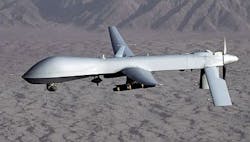Air Force chooses Space Computer for advanced persistent-surveillance sensor processing
WRIGHT-PATTERSON AFB, Ohio, 2 Sept. 2012. U.S. Air Force researchers are choosing embedded computing experts at Space Computer Corp. in Los Angeles to upgrade sensor processing in the Air Force Airborne Cueing and Exploitation System Hyperspectral (ACES Hy) side-mounted persistent-surveillance sensor for the MQ-1 Predator unmanned aerial vehicle (UAV).
Officials of the Air Force Research Laboratory at Wright-Patterson Air Force Base, Ohio, awarded a $2.1 million contract to Space Computer last Thursday as part of the ACES Hy Processor Upgrade Rapid Innovation Fund (RIF) Program. Space Computer was acquired in July by ITT Exelis in McLean, Va.
The ACES Hy program uses hyperspectral sensors, which collect target data using many optical bands in the electromagnetic spectrum to help U.S. and allied forces locate the facilities where terrorist make improvised explosive devices (IEDs).
ITT Exelis also is involved in another persistent-surveillance program called the Vigilant Stare Wide-Area Airborne Persistent Surveillance (WAPS) system for manned aircraft with partner Sierra Nevada Corp. in Sparks, Nev.. Vigilant Stare will provide visible and infrared coverage of moving objects in city-sized areas.
Hyperspectral sensors such as those in the ACES Hy program can separate the spectral properties of IED substances and other suspicious materials to enable hyperspectral sensors to filter optical bands and tailor them for specific missions. ACES Hy is under development by the Raytheon Co. Space and Airborne Systems segment in El Segundo, Calif.
ACES Hy detects optical bands the near-visible to the midwave infrared spectrum, which makes it suitable for deciphering camouflage and aerosols that might emanate from bomb-making locations.
Space Computer specializes in advanced sensor processing, with an emphasis in hyperspectral sensor data. Company experts have developed real-time and off-line hyperspectral processing tools to help evaluate advanced sensor system data. ITT Exelis Space Computer provides algorithms, real-time processor hardware, system integration, custom applications, sensor system data analysis, and field support.
The Air Force Rapid Innovation Fund is to help small businesses meet critical military needs with clear paths to major acquisition programs, such as ACES Hy. The program focuses on moving advanced technologies quickly to the field -- particularly involving precision air delivery, low-metal or non-metallic detection devices, and persistent wide-area airborne surveillance.
For more information contact ITT Exelis Space Computing online at www.spacecomputer.com, Raytheon at www.raytheon.com, ITT Exelis at www.exelisinc.com, or the Air Force Research Laboratory at www.wpafb.af.mil/AFRL.
Follow Military & Aerospace Electronics and Avionics Intelligence news updates on Twitter

